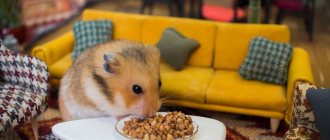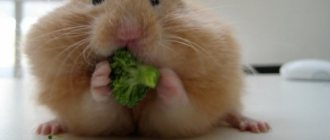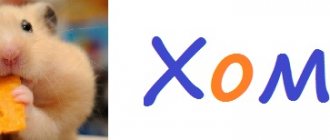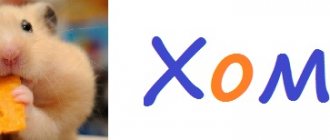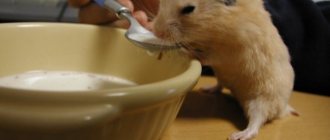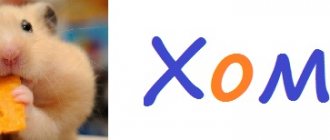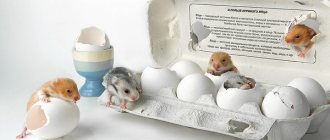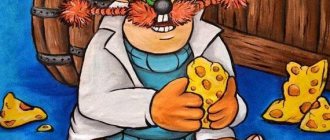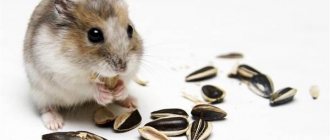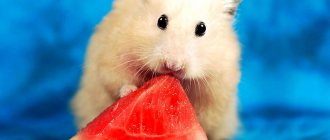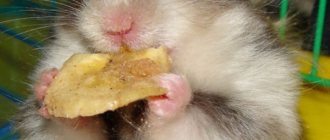Hamsters have become one of the popular caged animals. These little creatures come in many varieties, but some of the most famous are the Djungarian and Syrian hamsters. To keep a furry pet you only need a cage, a bowl and a drinking bowl. But careful care is also needed, feeding hamsters is an important part of caring for them so that they have good health and live a long life within their limits.
Buckwheat
Hamsters not only can eat buckwheat, but they also need it. Buckwheat is a storehouse of vitamins and microelements. It is an easily digestible product that is high in iron, protein and low in carbohydrates.
Buckwheat has a beneficial effect on blood circulation, brain function, nervous system and the general condition of the pet’s body. Increases endurance and removes toxins from the body.
It is recommended to give buckwheat in dry form to healthy pets. It helps maintain the health of your pet's teeth. Sick hamsters are given specially prepared buckwheat. You should not cook the cereal, it will lose its beneficial properties. Soak in hot water and leave overnight. Then dry the porridge and give it to the animals.
Do not brew porridge with milk. Dairy products are poorly digestible by hamsters and negatively affect their well-being.
Article on the topic: Can Djungarian and Syrian hamsters be given bananas?
To summarize, hamsters can be given buckwheat either raw or specially prepared. But don't limit your pet's diet. It is strictly prohibited to exclude dry food, fruits and vegetables.
Admission rules
You must understand that hay is one of the components of a hamster's diet, which also includes grains, fruits, etc. The animal needs a varied vitamin diet. Do hamsters eat grass from birth? It is better to start when the hamster reaches the age of one month - when the ventricle is sufficiently strong. The first portions should be small and consist of soft types. Watch to see if your baby willingly eats one or another type.
Rinse your greens thoroughly to remove dirt and any bacteria. Feed your fluffy young greens, as they contain more vitamins and are gentler on your pet's stomach. The dead ones should be removed promptly, as they will soon begin to rot. Explain to the children not to give their little friend “extra” food.
Grass for hamsters is a mandatory part of the menu. It is the main natural source of vitamins and minerals for the body. The main rule is to understand whether hamsters can have this or that type of grass, in what quantities and in what form it can be given.
Millet and wheat
Don't confuse millet and wheat. Millet is a cereal that is poorly digestible by hamsters. You cannot add it to the animal’s diet. Wheat is a grain and is useful for the animal. This product is added to many dry foods.
Sprouted wheat is especially useful. You can buy it at a pet store or germinate it yourself.
It is not recommended to buy cereals from unverified places. The hamster can be poisoned by the chemicals contained in the food.
Catering
A new product should be introduced into the diet of a Djungarian hamster in small pieces, and the reaction and condition should be observed. Gradually the volume is increased.
So, the pet’s menu should include basic food, the food should be enriched with fruits, vegetables, and herbs from the list of recommended products.
Hamsters eat frequently, and they also store food. Spoiled food should be removed from the house to avoid rotting and mold. In addition to spreading unsanitary conditions, the hamster can become poisoned.
Organizing meals at home is not difficult. In order for your hamster to feel good, it is important to avoid prohibited foods, not feed it human food, and keep the cage clean. Only in this case will the dzhungarik feel good, please the owner with funny behavior and live the time allotted to him.
Pearl barley
It is allowed to give pearl barley to hamsters. It is rich in nutrients and beneficial elements. Has a beneficial effect on the health of the animal.
You can prepare the cereal according to the buckwheat principle by soaking it in hot water. Barley, dry or slightly steamed, is given to the animals in small quantities and the remains are removed immediately after the end of the “meal”. If an animal steals a treat into a corner, it can cause harm later.
Rice is difficult for hamsters to digest. It is recommended to feed rice only in extreme cases, in case of digestive problems and certain diseases. Otherwise, avoid this supplement.
What does a rodent eat in nature?
Being an omnivore, the hamster eats almost everything that comes into contact with it. The exact diet is determined by the habitat. If a rodent lives in a steppe or semi-desert, it feeds on protein foods, including:
- Insects.
- Snails.
- Zhukov.
- Worms.
The importance of protein feed increases after hibernation or during gestation.
Field and garden individuals eat greens, fruits, cereals and vegetables. Feeding domestic pets should completely replicate the diet of their wild counterparts.
The natural instinct of hamsters is to be thrifty. Therefore, closer to the winter season, they fill up their storage. In this case, the pantry must be located in a hidden place and inaccessible to other animals. When keeping a rodent at home, you will need to periodically remove supplies, since food quickly spoils and emits an unpleasant odor.
Other cereals
Hamsters are allowed to give oatmeal. In dry form it is especially useful. Helps keep teeth healthy and has a beneficial effect on digestion. Dry cereal contains more nutrients. The steamed one is suitable for sick and small animals.
Hercules is a type of oatmeal that is also suitable for feeding hamsters. Rolled oats are softer than rolled oats. Easier to be absorbed by the body.
Sprouted oats can be used as a dietary supplement. Contains substances that have a beneficial effect on the appearance of the coat, the condition of the teeth and bone tissue of the rodent.
You can give semolina porridge to animals, but it is not recommended. It is also difficult to digest and will not bring much benefit. It is allowed to give semolina cooked in water. Milk and spices are strictly prohibited.
Article on the topic: Can hamsters have watermelon, why is this product dangerous for Djungarian and Syrian hamsters
Hamsters love to eat lentils dry and steamed. Grains contain useful microelements and vitamins, as well as fatty acids. They have a beneficial effect on pets’ digestion and general condition.
Lentil porridge can be given to both healthy and sick animals. It helps with toxin poisoning and quickly removes them from the body.
It is strictly forbidden to give muesli to animals. The mixture is not a cereal and contains a large amount of substances harmful to babies. Salt, sugar, artificial colors and flavors are contraindicated for rodents.
How to stock up
Proper collection of hay for your pet is not so simple. The best place for safety is your own yard, but a small percentage of the population has this opportunity. Therefore, just try to pick plants away from civilization, in the lap of nature. Gardening enthusiasts can try to grow fodder greens for their pets right on the windowsill or on the balcony.
What to do in winter? Is it possible to give hamsters grass sold on the shelves? It is not recommended to purchase plants in stores - they contain large amounts of nitrates and are unreasonably expensive. Therefore, freeze the future food or dry it, preserving all the beneficial properties.
What breeds of hamsters do these recommendations apply to?
The properties of cereals listed above and recommendations for introducing these products into the diet of animals apply to all breeds of hamsters.
Djungarians can be given the same cereals as Syrian hamsters. And vice versa. The breeds differ in external characteristics and character. Taste preferences can also be different. If the animal does not eat some kind of porridge, do not force it.
Do not limit your pet to one type of cereal or food. Feed your hamster a balanced diet. Add a variety of cereals, cereals, vegetables, fruits, cereal mixtures and dry food.
Supplement the diet with porridge, find out what cereals can be given to hamsters. This measure will help keep your pet healthy and active. A healthy hamster has shiny, soft fur. He is active and has a good appetite. If there is something wrong with your pet, check the diet. If necessary, contact a specialist.
Treats for your hamster
Despite the fact that hamsters only need a mixture of grains and periodic treats in the form of fruits or berries in their diet, there is a desire to diversify their diet with a pleasant treat. Treats for hamsters can be bought at the store, they are called drops, and there are also ways to make them yourself.
Banana sticks
To make a banana stick you need to cut a small piece of banana, mash it in a bowl, add any grains, you can also add some seeds, mix well together. Roll the finished mass into a bar. Leave in a warm place overnight, or you can also put it in the microwave for a minute to let the mixture set. The stick should be semi-solid.
Fruit treat
To prepare this delicacy for one hamster you need:
- Grape berry.
- Raspberry berry.
- Apple slice.
- A teaspoon of honey.
- A mixture of cereals and seeds.
Berries and an apple slice must be peeled and seeds removed and made into a soft mass. Add honey to the resulting substance; you need to round it and roll it in a mixture of cereals. Afterwards, the spherical treats should dry out, after which the sweet treat goes to the hamster.
What cereals can hamsters eat?
For normal life, the diet of a pet hamster must be complete and varied. In this article we will look at what cereals can be eaten by hamsters and what other legumes can be used to diversify your pet’s diet.
Whole grains contain vitamins such as vitamin B₁ (thiamine), B₃ (niacin), B₅ (pantothenic acid), PP (niacin) and several others. In addition, cereals contain various minerals: copper, manganese, molybdenum.
Article on the topic: What vegetables and fruits can be given to hamsters
Hamsters can eat the following grains and whole grains
Barley
Used to prepare barley and pearl barley. Barley is rich in vitamins, macro- and microelements. It contains vitamins A, B₃, B₉ and K, other vitamins are contained in smaller quantities. Lots of potassium, phosphorus, magnesium and copper. You can give your hamster both cereal and whole grains - but always without the shell, because it contains a lot of fiber.
Wheat
Has a wide variety of varieties. Wheat contains the most potassium and phosphorus, copper and iron, and folic acid. Dry grain is poorly digestible, so you need to add sprouted or soaked grains to the feed. Some experts believe that hamsters should not eat wheat. However, eating wheat porridge is acceptable.
contains B vitamins, as well as potassium, magnesium, calcium and phosphorus. It is preferable to feed oats at the stage of milky-wax ripeness or in the form of oatmeal.
Buckwheat
Easily absorbed by the body. It contains iron, potassium, phosphorus and magnesium.
From legumes, hamsters can:
Young green peas are a source of amino acids, iodine, phosphorus, vitamins A, E, C
- Lentils contain niacin, potassium, phosphorus, iron and zinc;
- Green beans are rich in carotene, iron, zinc;
- Chickpeas need to be soaked overnight before giving them to your hamster. It contains a lot of proteins, vitamin C, choline, potassium and iron;
- Only sprouted mung beans It contains a large amount of B vitamins, folic acid, magnesium and sodium.
The range of cereals that hamsters can eat is quite wide, and cereals can be supplemented with legumes and other grains. It is important that when porridge is included in the diet, it should be cooked in water without adding salt. Sometimes you can flavor them with vegetable oils.
Article on the topic: Can hamsters have boiled and raw eggs, white and yolk for Djungarian and Syrian hamsters
Can a hamster eat buckwheat and rice?
Since childhood, we have all been familiar with the taste of porridge with buckwheat and rice, and the words “I ate little porridge” are no less familiar. But indeed, porridge is not only an easily digestible product, but also very healthy and necessary.
Buckwheat is famous for its reserves of vitamins B, PP and E, fiber, protein, iodine, iron and phosphorus. This is a very useful product, especially for the younger generation. Can a hamster eat buckwheat and in what form (in the form of cereal or porridge)? This frequently asked question is not difficult to answer.
It would not be amiss to remind you that the basis of the correct diet of any hamster is dry food: grain mixtures. Buckwheat is grown in fields on an industrial scale; local wild hamsters use it with pleasure and benefit. So why not treat your pet rodent to buckwheat?
Buckwheat can be given to without fear in the form of dry cereal . In this form, it is part of the usual diet. However, it is worth noting that it is impossible to completely switch to a buckwheat diet; use the golden rule - what is too much is not healthy. We recommend using high-quality grain mixtures, where all components are proportionally balanced according to the hamster’s need for them. This way, you don’t have to worry about what food and how much to feed your furry pet.
Buckwheat rice and rice porridge are slightly less popular. Many people like it just as much, but can it be given to a hamster? Rice is also a very healthy product, however, it will be heavier for the hamster’s body than buckwheat. Experienced hamster breeders recommend giving rice to feed young animals and in case of illness. Rice porridge and its broth will come in very handy in case of smuggling.
Rice water has the ability to effectively restore the balance of water in the body. It is recommended not only for hamsters, but also for their owners to take it if they carry it. You can give a little in the form of porridge, boiled until sticky.
Article on the topic: Can hamsters have raw and boiled potatoes?
Recommended Products
In the wild, hamsters eat mainly grain crops; this nuance can be taken into account when composing the diet of the dzhungarik.
In addition to grain crops, in the wild hamsters can also eat animal food, sometimes turning into a predator, eating carrion or killing smaller animals. At home, you should take this factor into account when choosing food.
Special dry food
Diet at home must include special grain feed.
There are a huge variety of them on our market, so you can offer the dzhungarik a choice and follow his preferences. In addition to their composition, they differ strikingly in their quality, which is also worth paying attention to. The case when a home protests and flatly refuses a certain brand is far from uncommon. Also, you should not feed your Djungarian hamster with grain mixtures intended for other animals.
Protein food
A couple of times a week you should feed the jungarik with protein foods, such as cottage cheese or a piece of boiled chicken; a boiled chicken or quail egg, or low-fat boiled fish are perfect. All of the above products must be prepared without spices and seasonings that are harmful to the small body.
Let's look at the list of products that you can still feed the homa:
| Cereals: | Nuts: | Seeds: | Greenery: |
|
|
|
|
Before feeding homa with parsley, dill and other herbs, rinse and dry it thoroughly. Thanks to this simple procedure, moisture that may contain harmful substances will disappear. Remember that parsley has a laxative effect and should not be given if the homa is pregnant.
Buckwheat and other cereals
The usefulness of buckwheat for hamsters does not even need to be proven. The vegetable protein, minerals and vitamins present in it make it truly the No. 1 dish for hamsters. In addition, it is also useful for the hamster’s teeth, which need to be loaded with solid food. Buckwheat approaches from all sides. As, indeed, other cereals, such as rice, millet, barley, oats, pearl barley. You can eat buckwheat in dry form, or you can cook porridge. Only it should be cool and cooked in water, not milk. Milk is poorly digested by the delicate digestive system of hamsters. Other types of porridges are also useful: wheat, oatmeal, rice, semolina. Naturally, they should be without sugar and oil. Porridge is usually prepared for sick, weakened hamsters. Dry cereals are more suitable for healthy people. We believe that the question of whether hamsters can eat buckwheat has been sufficiently covered.
More about the benefits of cereals
Sprouted grains, in particular wheat, are also very useful for hamsters. It is not difficult to germinate. The wheat grains are first soaked for some time, and then, covered with a lid, placed in a warm place for a couple of days. You can do it another way: rinse and place the wheat grains on a flat plate. Cover the top with gauze moistened with water. In a day, two of the grains will sprout. Dry the sprouted grains and give it to your hamster - it will be better than any vitamin complex.
Article on the topic: What do hamsters like to eat most: treats, treats, store-bought and homemade treats
